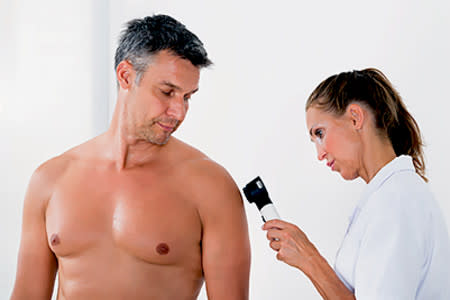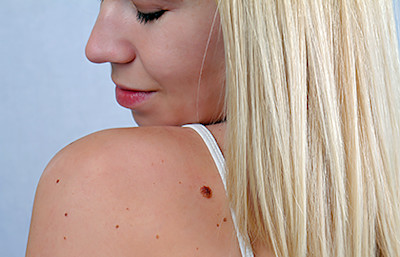When is a mole a problem?
Dermatologist examining a new mole
If you develop a new mole after age 30, a dermatologist should examine the mole for signs of melanoma.

#1 problem with moles: Melanoma
While most moles are harmless, you shouldn’t ignore yours.
Melanoma, the most-serious skin cancer, can begin in a mole. A bleeding or itchy mole can be a sign of melanoma. If you are 30 years old or older, a new or changing mole could also be a melanoma.
That’s why it’s so important to know what your moles look like. Found early, melanoma is highly treatable.
You’re more likely to spot melanoma early if you know:
Where you have moles
What your moles look like
To make it easy for you to know your moles, the AAD worked with dermatologists to create the Body Mole Map. On one page, you’ll find everything you need to check your skin, including the ABCDEs of melanoma.
If a mole looks different from the others, itches, bleeds, or is changing in any way, a dermatologist should examine it.

Other problems with moles
While melanoma is the most serious problem a mole can cause, it’s not the only one. A mole can be a problem if it:
Snags on clothing or jewelry
Is easily irritated
Looks unattractive to you
A harmless mole can rise above the surface of your skin. If clothing or jewelry rubs against (or gets caught on) this mole, it can irritate the mole. You may notice the mole and skin around it feel uncomfortable.
If you have a raised mole on skin that you shave, you may nick the mole, causing it to bleed. This can be bothersome.
A mole can also be a problem if it makes you feel unattractive. Some people consider a mole more of a blemish than a beauty mark.
When a mole is a problem, it’s best to have a dermatologist examine it and decide whether it needs to be removed.
A dermatologist can remove a mole that is easily irritated or makes you feel unattractive.

Mole removal: Why a dermatologist should do it
Trying to get rid of a mole with home remedies can do more harm than good. Homemade pastes that you apply to the mole can cause an allergic skin reaction, leaving you with red and raw skin. You’ll usually also still have the mole.
If you try to shave off a mole, you may leave some of the mole in the skin. With shaving (or cutting), you also risk getting a serious scar or infection.
Tattooing over a mole isn’t a great option either. If melanoma later develops in the mole, it can be hard to see the early signs. Given time to grow, melanoma can spread, making treatment difficult.
A dermatologist can remove most moles during an office visit, without any downtime.
Insurance typically covers the cost, unless you’re having the mole removed because you dislike the way it looks.
Another advantage of having a dermatologist remove a mole is that the removed mole will be checked for signs of melanoma.
Having your mole checked for melanoma is important. If melanoma is found, you’ll be able to get the treatment you need. Finding out that your mole is harmless can give peace of mind.
Related AAD resources
Images
References
Mori WS, Peters KV, et al. “Tattoo artists’ approach to melanocytic nevi.” JAMA Dermatol. Published online January 18, 2017.
 Atopic dermatitis: More FDA-approved treatments
Atopic dermatitis: More FDA-approved treatments
 Biosimilars: 14 FAQs
Biosimilars: 14 FAQs
 How to trim your nails
How to trim your nails
 Relieve uncontrollably itchy skin
Relieve uncontrollably itchy skin
 Fade dark spots
Fade dark spots
 Untreatable razor bumps or acne?
Untreatable razor bumps or acne?
 Tattoo removal
Tattoo removal
 Scar treatment
Scar treatment
 Free materials to help raise skin cancer awareness
Free materials to help raise skin cancer awareness
 Dermatologist-approved lesson plans, activities you can use
Dermatologist-approved lesson plans, activities you can use
 Find a Dermatologist
Find a Dermatologist
 What is a dermatologist?
What is a dermatologist?